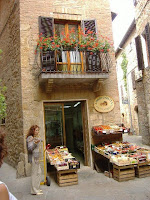
I so hate to say "good bye" to summer, but fall sure does provide us with some delicious foods! From crisp apples, pears, sweet potatoes and one of my favorites- butternut squash. I love them all.
Butternut squash is a fairly versatile vegetable and can be used in a variety of dishes. It's sweet taste can satisfy any sweet tooth, like mine, without the guilt of added sugars. I have come to enjoy butternut squash in a number of ways including soup, casseroles, and even apple and squash dessert.
Butter nut squash is rich in vitamin A and C and is low in calories (1/2 cup is only 40 calories). It is plentiful during the fall and winter months, keeps well and for a long period of time if stored in a cool spot.
The only challenge I have found with cooking butternut squash is it's tough skin, which is difficult and sometimes dangerous to cut. To avoid cutting yourself,wash squash off, poke holes in it with a fork and place it in the microwave for a few minutes, depending on the size of the squash. After 3 minutes or so, the skin and flesh have softened enough that you can then safely cut it open without risking cutting yourself.
Try some of my favorite Butternut squash recipes-
Roasted Butternut SquashIngredients
1 butternut squash
olive oil
salt and pepper
Directions
1. wash your squash by running under warm water. dry it off with a paper towel
2. poke holes in the squash with a fork on 4 sides and the neck
3. place in microwave for 2-3 minutes
4. remove from microwave and let cool for a few minutes or until comfortable to touch
5. place squash on a cutting board and cut the ends off of the squash. Stand squash on end and peel skin off with a sharp knife.
6. slice squash into about 1/2 inch slices.
7. place squash slices on a cookie tray that has been greased with olive oil. Brush top side with olive oil. Salt and pepper to taste
8. place tray in the oven under the broiler and roast for 7 minutes. Check squash frequently to ensure it does not burn. Return to broiler if more time is needed.
9. Enjoy with your favorite protein- baked chicken, pork chop etc.
Butternut Squash SoupIngredients:
• 2 lbs butternut squash, peeled and cut into chunks
• 4 cups low-sodium, low-fat vegetable broth
• 1 1/4 cup non-fat sour cream
• 2 Tbsp butter
• salt and freshly ground black pepper
• 1/4 tsp cayenne, or to taste
• 1 cup mushrooms, sliced
• 1/4 cup chives, cut into 1-inch pieces
Directions:
Combine the squash and vegetable broth in a saucepan and bring to a boil over high heat. Reduce the heat to medium, and simmer for about 20 minutes or until the squash is very tender.
Let cool, and then puree the mixture in a blender. (You may prepare the recipe in advance up to this point; you can keep the mixture refrigerated in a covered container for up to 2 days.)
Return the puree to the saucepan and turn the heat to medium-low. Stir in the non-fat sour cream along with the butter, cayenne, and salt and pepper to taste. Cook and stir until heated through; (do not boil). Then taste and season, if necessary. Keep warm over low heat.
Meanwhile, heat skillet over moderately high heat until very hot. Spray with cooking spray, then saute mushrooms, stirring, until golden brown, about 5 minutes.
Serve the soup with sauteed mushrooms and chives.
Nutritional information per serving: Calories 152, Fat 4g, Carbohydrates 25g, Protein 6g, Cholesterol 11mg, Fiber 2g, Sodium 174mg.
Reprinted with permission from the Centers for Disease Control and Prevention 5 a day website. More recipes are available at www.5aday.gov/month/index.html


























